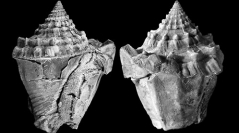

 Geodiversitas
40 (11) - Pages 211-257
Geodiversitas
40 (11) - Pages 211-257Gastropods and bivalve associations from the middle and ?upper Eocene (Bartonian and ?Priabonian) sedimentary succession of the Pamplona Basin are described. This succession was accumulated in the western part of the South Pyrenean peripheral foreland basin and extends from deep marine turbiditic (Ezkaba Sandstone Formation) to deltaic (Pamplona Marl, Ardanatz Sandstone and Ilundain Marl formations) and marginal marine deposits (Gendulain Formation). Fossils are generally fragmentary and many correspond to remains that have undergone taphonomic reworking. Significant effects of diagenesis are also detected, with evidence of compression or deformation, dissolution, aragonite-calcite neomorfism and cementation by celestite. Bioerosion traces and fossil encrusters are common. Fossils of 37 taxa, 25 gastropods and 12 bivalves, have been identified confidently. The number of species is probably considerably higher, as the study of some fossils, mainly the most small-sized species, is pending. One new species, Athleta (Volutospina) delvallei Astibia, Merle & Pacaud, n. sp. (Gastropoda, Volutidae), is described herein. Fossil assemblages are comparable to those from the Eocene of the Basque Coast (North Pyrenean area) and Aragon and Catalonia (west-central and eastern part of South Pyrenean area). Most of the mollusc taxa seem to be endemic to the Pyrenean area, but several Tethyan and Northern elements have also been recorded. These results enlarge the database for a better understanding of the evolution of global marine biodiversity throughout the Eocene.
Gastropods, bivalves, Paleogene, shallow-marine sediments, Pyrenean area, new combinations, new species